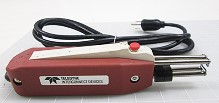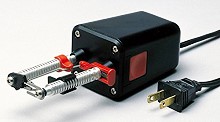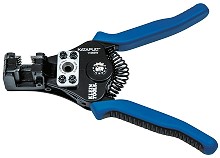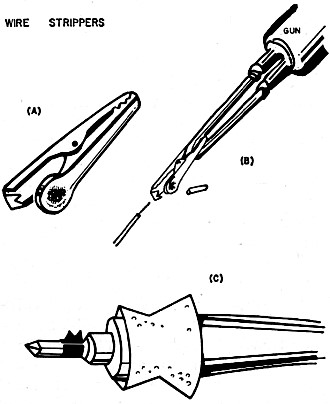Solder Gun Thermal Wire Stripper
|
|
Hidden away on page 134 of a 1959 issue of Electronics World, at the end of a Mac's Service Shop-like electronics shop docudrama (Another Day in the Shop) is this handy tip on how to fabricate a make-shift wire stripper from a soldering gun or a soldering iron. The beauty of thermal strippers over mechanical strippers is that they do not nick the underlying metal wire. Heated elements melt the insulation and then a blunt edge is used to slide the insulation off the end of the wire. Another advantage is that you can strip a wide range of wire gauges and insulation types without needing to adjust the jaws or change to a different hole location - although a proper temperature setting is required to avoid a gloppy, stringy mess. Commercial wire, unlike Mil-Spec wire, can have a very wide variation of wire and insulation thicknesses for a given advertised gauge. When I built Mil-Spec electronics assemblies at the Westinghouse Oceanic Division in Annapolis, Maryland, after getting out of the USAF, we were required to use thermal strippers on Teflon-insulated wire. Mechanical types were allowed for plastic insulation, but Teflon was considered too tough to get a good, clean stripping job. Thermal wire strippers are also nice when working inside a tight space because not much lateral room is needed and almost no torque or strain is placed on the wire. Thermal wire strippers are not cheap. Although evidently not manufactured anymore, the Teledyne type thermal stripper shown to the left is what we used. When available on eBay or Amazon, they typically sell for north of $300. Patco makes the thermal stripper unit shown below the Teledyne model. You can pick up a new Patco unit for under $150. Solder Gun Wire Stripper By Fritz C. Hoffman
To make up the wire snipper, cut a "V" into the very tip of the clip, and then bend this tip over 90 degrees as shown in (A). The entire unit is then clipped onto the tip of the soldering gun, as shown in (B). Now all you have to do is press the trigger of the gun and rotate the adapted tip around the wire to be stripped. With the help of the applied heat, insulation comes off cleanly and quickly. Where a considerable amount of stripping is to be done, as in wiring up kits, a stripping clip can be made up for use on a regular or pencil type iron. Shown in part (C), this adapter can be fashioned from copper and left permanently in place on the iron. While this version may not work quite as well as the gun adapter in close quarters, it is more practical for extensive work and is always at hand when needed.
Posted July 9, 2018 |
|




 When insulation must be removed from wire, an irritating
situation usually results, especially when the wire involved is in a cramped working
space. A slender knife might work, but even the slight nicks that inevitably result weaken
the wire and thus tend to invite breakage. The little device shown in parts (A) and (B)
of the accompanying illustration, made from a miniature, copper alligator clip of the
"Minigator" type, solves the problem neatly.
When insulation must be removed from wire, an irritating
situation usually results, especially when the wire involved is in a cramped working
space. A slender knife might work, but even the slight nicks that inevitably result weaken
the wire and thus tend to invite breakage. The little device shown in parts (A) and (B)
of the accompanying illustration, made from a miniature, copper alligator clip of the
"Minigator" type, solves the problem neatly.